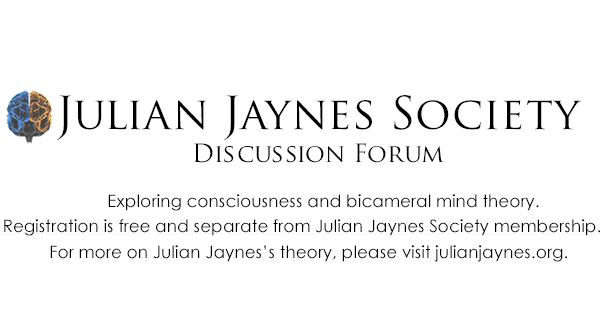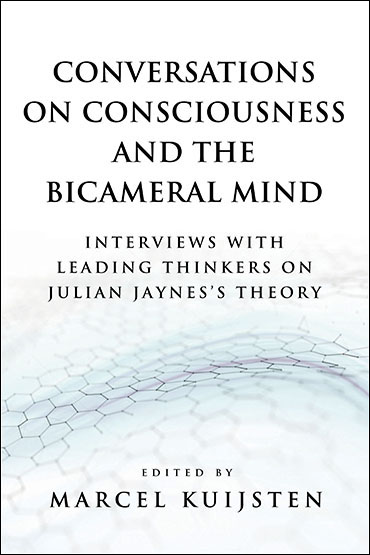Expansion of Jaynes’ Wahee-Wahoo Hypothesis for Speech/Language Evolution
Martin L. Lenhardt, paper presented at The Julian Jaynes Society Conference on Consciousness and Bicameral Studies, Charleston, WV, June 2013.
Abstract: Jaynes’s paper entitled ‘The Evolution of Language in the Late Pleistocene” presented at the 1976 New York Academy of Sciences meeting summarized his views on speech/language evolution. Jaynes received considerable criticism, chief of which was directed at his relatively later date of the emergence of speech in our species. Jaynes started with alarm calls, which likely existed in some form in prehuman primate species. His specific example was a warning cry of wha which changes in intensity with the threat level and can be directed to specific (moving) objects. An specific approaching dangerous object might elicit a cry of wahee whereas the same departing object might elicit a more relaxed vocal gesture as wahoo. Although Jaynes never specified the wahoo would likely be longer in duration with a falling pitch contour. The wahee would likely be shorter in duration to accommodate more calls per breath in an excited state which would likely be characterized by a flat or rising pitch contour. These contours have linguistic meaning today and are one of the first discernible by infants and processed on the right side of adult brains. It would appear there was a fitness advantage for individuals developing a vocal alarm system of this nature. I will argue in this presentation it is the complex acoustical nature of these calls that was selected for but not, as most suggest for communication, but as an aid in auditory localization within a social group. Jaynes’s concept that the call endings later separated from the calls to become modifiers is reasonable in the sense that hee and hoo were functionally distinct and have a specific auditory neural substrate.
Please sign up or login to watch the full version in the JJS Member Area.
Martin L. Lenhardt – Expansion of Jaynes’ Wahee-Wahoo Hypothesis for Speech/Language Evolution
Section for discussing lectures related to Julian Jaynes's theory of the origin of consciousness and a previous bicameral mentality.
Return to “Lecture Discussion”
Jump to
- JJS Forum
- ↳ General Discussion
- ↳ News Items Related to Jaynes's Theory
- ↳ Book Discussion: The Origin of Consciousness and Julian Jaynes Society Publications
- ↳ Myths, Misconceptions, and Fact Checks About Julian Jaynes's Theory
- ↳ Brian J. McVeigh's Random Thoughts
- ↳ Julian Jaynes
- ↳ Conferences, Events, and Local Discussion Groups
- ↳ Lecture Discussion
- ↳ Interview and Q&A Discussion
- ↳ 1.0. Hypothesis One: Consciousness Based On Language
- ↳ 1.01. Hypothesis One: Consciousness Based On Language | Subtopic: Consciousness & Dreams
- ↳ 1.02. Hypothesis One: Consciousness Based On Language | Subtopic: Consciousness in Children
- ↳ 1.03. Hypothesis One: Consciousness Based On Language | Subtopic: Consciousness and AI
- ↳ 2.0. Hypothesis Two: The Bicameral Mind
- ↳ 2.1. Hypothesis Two: The Bicameral Mind | Subtopic: Auditory Hallucinations in Normal Adults
- ↳ 2.2. Hypothesis Two: The Bicameral Mind | Subtopic: Hallucinations & Imaginary Companions in Children
- ↳ 2.3. Hypothesis Two: The Bicameral Mind | Subtopic: Hypnosis, Possession & Altered States of Consciousness
- ↳ 2.4. Hypothesis Two: The Bicameral Mind | Subtopic: Religion & the Bicameral Mind
- ↳ 2.5. Hypothesis Two: The Bicameral Mind | Subtopic: Schizophrenia
- ↳ 2.6. Hypothesis Two: The Bicameral Mind | Subtopic: The Mentality of Pre-Literate & Pre-Modern Peoples
- ↳ 3.0. Hypothesis Three: Dating the Development of Consciousness
- ↳ 4.0. Hypothesis Four: Jaynes's Neurological Model for the Bicameral Mind
- ↳ The Bicameral Mind in Fiction, Film & Popular Culture
- ↳ Information for Students


